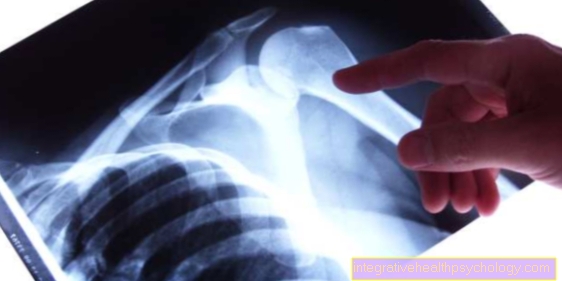Coccyx fistula
definition
A fistula on the coccyx is a chronic inflammatory disease in the area of the gluteal folds (lat. Rima ani). As a rule, mainly patients between the ages of 20 and 30 present to the family doctor because of the presence of a coccyx fistula. It is estimated that around 26 out of 100,000 people in Germany develop a coccyx fistula every year. A similar clinical picture can occur between the individual fingers or toes. However, the reason for this phenomenon has not yet been conclusively clarified.

causes
About the Emergence There are many theories about a coccyx fistula. In medicine and in everyday clinical practice three these theories that are most likely to be accepted are established. It is now believed that the development of a coccyx sinus is associated with the daily exposure of the skin and Soft tissues in the area of Coccyx is directly related. Frequent sitting, thick hair and that caused by it Hair ingrowth are assumed to be the cause. Here the penetration of the hair tips into the plays above all epidermis an important role. In addition, an error can already occur during the Hair formation (so-called Hair disorder) lead to the development of a coccyx fistula. In these cases it can be proven that the Root region educated keratin could not be built up into a hair in order. Rather, it comes to one clod-shaped deposit of the keratin and based thereon to the formation of a so-called Foreign body granuloma.
By infection With bacteria the normal skin flora arise in the affected areas purulent inflammation. This theory is based on finding Tufts of hair in the fistula duct or in the Abscess cavity affected patients.
Another assumption describes the relationship between congenital malformationsthat were already used in the course of the embryonic neural tube occlusion originated.
In addition, it is assumed that enormous forces are exerted during a Trauma favor or even provoke the formation of coccyx fistulas.
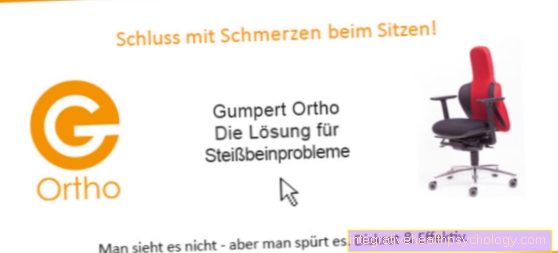
Symptoms
A coccyx fistula can manifest itself through a variety of symptoms. The tricky thing about this condition, however, is that in some people it becomes complete over a long period of time asymptomatic expires and for this reason only very late can be diagnosed and treated.
As a rule, the presence of a coccyx is caused by the sudden onset of severe pain in the field of Buttock region noticeable. Affected patients are no longer able to travel long distances, for example to run or towards the buttocks sit. Any burden the rump region leads to an increase in the pain symptoms. In some patients this occurs Pain perception but only very late or not at all.
Sometimes those affected only describe one Pulling over the rump. Other symptoms of coccyx fistula are local redness and Overheatingthat on the inflammatory processes inside the fistula. Swelling in the field of Anal fold usually have purulent processes inside the fistula. The emergence of pus and or bloody secretions is not noticeable in all patients. Bloody ones, yellowish deposits on the underwear can be a first indication of the presence of a coccyx fistula.
Stages of the coccyx fistula
The clinical staging in the presence of coccyx fistulas is different three relevant course forms. It is divided into: bland, acutely abscessing and chronic fistulous form.
- Bland shape
This is the mildest type the coccyx fistula. The bland form is in contrast to the acute or chronic type no signs of inflammation on. The affected patients notice neither Redness or swelling, yet overheat or pain in the area of the coccyx fistula. As a rule, coccyx fistulas can only be of the bland form few (maximum one or two) Fistula openings found on the surface of the skin.
- Acute abscess form
The heavy load the buttock region as well as a excessive hair quickly lead to the penetration of whole Hair hair in the epidermis. The organism calls these hairs foreign body perceived. In addition, they educate for bacterial pathogens an ideal Entry gate in the body. Since an unspeakable number of bacterial pathogens persist in the buttock region, it happens quickly Infections of the skin. Also promotes heavy sweating by forming a humid and warm environments bacterial growth. As a result, there are strong local inflammation and education purulent secretions. This applies in particular to this form of development apple-shaped vessels and very overweight as relevant Risk factors for a coccyx fistula.
- Chronic fistulous form
In the case of the chronic fistulous form of the coccyx fistula, as a rule no acute signs of inflammation (Redness, swelling, overheat, pain) determine. However, the majority of affected patients complain about that permanent secretion of purulent secretions (Fistula secretion). Also the exit light-colored and / or bloody liquids from the fistula is possible.
The danger with chronic fistulous courses consists in the fact that it increases within a few days enormous increase in size the tissue change and the coccyx up to Fist size can swell. In these cases, affected patients are affected by severe pain plagued.
Diagnosis
The most important step in diagnosing a coccyx fistula is a detailed one Doctor-patient conversation (anamnese). Based on the detailed description of symptoms, the Suspected diagnosis Coccyx fistula. In addition, is a physical examination of the patient concerned. During the inspection (Consideration) the anal region may fall local redness and Swelling on. In addition, in many cases small openings the fistula ducts in the area of the Gluteal crease to find.
Which doctor is responsible for treating coccyx fistula?
If you notice something in yourself that deviates from the normal state, be it a simple symptom like a headache or a physical change such as a noticeable pimple or "Hubbel“It is never wrong that Family doctor to seek out. The family doctor is responsible for classifying whose area of responsibility an illness falls into and the patient to one Specialist to transfer who can help if it is a more specific problem. So if you are unsure which specialist is responsible, it is best to first see your family doctor.
Coccyx fistulas are a dermatological problem, since these are changes that the skin and affect the surrounding tissue. Of course, if there is a suspicion, you can immediately consult a dermatologist who will make this diagnosis immediately.
Since coccyx fistulas must always be operated on, the next step is this Referral to the surgeon. The operation can be done on an outpatient basis or in the hospital. This also differs from case to case. In any case, surgeons will of course act. Often dermatologists also have this additional specialist training.
Figure tailbone pain
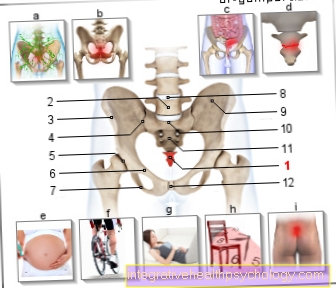
- Tailbone - Os coccyxis
- Fifth lumbar vertebra -
Vertebra lumbalis V - Iliac crest - Iliac crest
- Sacrum-iliac joint
(Sacroiliac joint, abbreviated ISG)
Articulatio sacroiliaca - Hip joint - Articulatio coxae
- Pubic bone - Pubis
- Ischium - Os ischii
- Intervertebral disc -
Intervertebral disc - Iliac bone - Os ilium
- Lumbar cruciate ligament kink -
Promontory - Sacrum - Sacrum
- Pubic symphysis -
Pubic symphysis
Coccyx pain - coccygodynia
a - Nerve Pain - The region of the body
becomes of plexus of nerves
(Plexus coccygeus) supplied
b - inflammation of the tendons,
Muscles or bones -
chronic loads or germs
c - rectum and anus, chronic
inflammatory bowel disease
(Ulcerative colitis, crohn's disease)
d - Coccyx fracture, coccyx contusion -
Swelling, bruising (due to
Fall, kick, etc.)
e - pregnancy
(hormonal changes) -
usually in the 1st and 3rd trimester
f - sport - tensioning the ligaments
and muscles (e.g. cycling, rowing)
g - Lying for a long time - (older and
bedridden people)
h - microtraumas - prolonged sitting
on hard chairs
i - coccyx inflammation - redness,
Swelling, fistula (Pilonidal sinus)
You can find an overview of all Dr-Gumpert images at: medical illustrations
therapy
Unlike many other diseases, when there is one there is Coccyx fistula no promising conservative treatment. The the only option mastering a pilonidal sinus is that surgical opening (Excision). Without surgery, a coccyx fistula cannot be treated, or only insufficiently. The surgical removal the cyst can occur in various ways that have become established in everyday clinical practice.
Classic surgery

In the course of classic surgery the coccyx is first with one dye (Methylene blue) stained. The staining enables the entire affected tissue to be removed completely and over a large area. In order to prevent a new coccyx fistula in the same localization (so-called Relapse), except for the Periosteum cut of the coccyx. After successful Clearance the fistula should be the Surface of the bony coccyx additionally scraped off become. The treatment of the fistula by means of surgery is usually carried out under general anesthetic.
At mild gradientswho have a small fistula system that has not yet been affected by inflammatory processes, the surgical intervention may be under local anesthesia be made. Although the treatment of coccyx fistulas is becoming more and more common outpatient should be carried out due to the possible postoperative complications Consider hospitalization for approximately three to four days.
After the treatment, the surgical area can in some cases locked immediately become. In some patients, however, it is necessary to do something called a secondary wound healing to choose. This means that the cuts are level not sewn but open be left. The choice of secondary wound healing has one for the patient long duration of illness result. Depending on the size and extent of the coccyx fistula, healing can take a period of several months include. In order to accelerate wound healing after a coccygeal fistula operation with open wound care, a Vacuum pump be applied. During the healing phase in secondary wound healing, however, care must be taken that the surgical site wet is held and the edges of the wound do not dry out.
OP with pit picking

The so-called Pit picking for the surgical treatment of a coccyx fistula was first used in the 80s by the American James Bascom described (synonym: Bascom pit picking operation). This method represents the smallest surgical intervention for the therapy of a coccyx fistula and reduces the Wound healing time therefore enormous.
The pilonidal fistula operation with pit picking is, in contrast to the classic operation, always outpatient carried out without a major hospital stay. In addition, this procedure does not need to be performed under general anesthesia. A simple and low-risk one local anesthesia the buttock region is completely sufficient. In addition, the surgical intervention with pit picking can be tackled immediately after the diagnosis and a detailed discussion. The actual surgery usually only lasts a few minutes and the treated patients can be discharged home after a short recovery period.
- Procedure:
Before the actual pilonidal sinus surgery with pit picking, a local anesthesia made in the buttock region. In order to ensure that the anesthetic is fully effective, there should be approximately one interval between the anesthetic and the start of the procedure ten minute break be respected. The operation with pit picking is carried out in Prone position carried out. In this way, the surgeon has a good overview of the operating area and can do so gentle proceed as possible. In the next step, the attending physician gets an overview of the extent of the coccyx fistula. Everyone visible Fistulous duct (so-called Pit) in the gluteal fold is then as tight as possible cut out. Of the Tissue loss in the pilonidal fistula operation with pit picking is many times less than in the classic operation.
However, even with this principle, treatment without surgery is not possible. As a rule, pit picking only creates cuts a few millimeters in sizethat can heal quickly and easily. In addition, there is a so-called crease on the side of the gluteal fold Relief cut carried out. This is usually about a length 2 cm and is used for emptying inflammable substances from the original fistula duct. In this way, the fistula ducts can be much better heal. Around Secondary bleeding It is easy to avoid using pit picking after the coccyx surgery Wound dressing created. In addition, the small wounds with Tamponades provided. After leaving the clinic, patients are encouraged to respond heavy bleeding to pay attention and, if necessary, to consult a doctor.
- Assessment of the treatment success:
Of the success The coccyx surgery with pit picking can be about four weeks assessed after surgery. The wound must completely dry be. Humidity or even weeping wounds suggest that pit picking has not had the desired effect. The Success rate pit picking is relative highHowever, in some cases it can happen that months after the procedure a new coccyx fistula develops. In this case, the OP can use pit picking repeated or the classic method should be considered.
Laser fistula obliteration (treatment with the laser)
The Laser fistula obliteration is a modified form of pit picking. In this procedure, the pilonidal sinus surgery is performed with pit picking using a laser. With the help of a thin Fiber optic probe the energy produced by the laser becomes Desolation of the inflammatory changed Fistula tissue utilized.
The laser fistula obliteration is an extremely gentle and precise procedure, which in addition to the obliteration of the fistula tissue also the Ingrown hair removal enables. Originally, laser fistula obliteration was first used to treat Anal fistulas used, but this principle has now become well established in the treatment of coccyx fistulas. The great advantage of laser treatment lies in the Tissue protection and the comparatively rapid wound healing. However, even with this method, the coccyx fistula cannot be completely removed without surgery.
Follow-up treatment after surgery
The patient himself can also make a major contribution to the successful wound healing after the operation. In general, however, this should always be discussed with the doctor and adapted to the wound.
But primary is one meticulous hygiene of the operated area is very important. Besides, the waiver is on Tobacco, alcohol and other Luxury foods essential for good wound healing. A healthy eating can help too.
Furthermore is a regular rinsing of the wound very important. The rinse is done several times a day above all else after defecation. The attending physician explains exactly what to look out for. As a general rule, if the wound has healed openly, you should let the wound dry for a few minutes after rinsing before closing it again with the tamponade. Liquids that are sterile, hypoallergenic, heatable, non-absorbable, odorless and atraumatic are generally suitable for irrigation. This includes Saline solution, Ringer's solution (Saline solution with additional Electrolytes how potassium and Calcium) and Wound irrigation solutions containing polyhexanide. Due to its antibacterial effect, the latter is particularly suitable for rinsing chronic and purulent wounds.
In addition to rinsing the wound, you can also Hip baths be very helpful. Sitz baths can be prescribed by the doctor, such as Potassium permanganate baths. But it can also be simple Sea salt baths be. They are used for antibacterial cleaning of the wound. In general, however, such measures should be discussed with the doctor.
From Wound healing ointments should be in prefer to drainunless explicitly prescribed by a doctor. Opinions are divided here as to whether they are Ointments for a coccyx fistula are good for wound healing. Also with homeopathic remedies and home remedies one should be very careful with. Especially with an open wound, the wrong handling of it can massively delay healing. Therefore: Consult a doctor before taking any action!
Of the Dressing change can be made more bearable with the help of a hip bath. This will soften the tamponage and prevent it from sticking to the wound. Lukewarm water is sufficient to moisten the wound. Chamomile extract however, in the water can provide additional relief due to the anti-inflammatory effects of chamomile.
Homeopathy for a coccyx fistula
Coccyx fistulas are always a case for the surgeon. With an untreated coccyx fistula there is a great risk of sepsis, when purulent secretions get into the bloodstream. Purely conservative treatment is not possible, all the more so not homeopathic. Since this is a disease which, if left untreated, can lead to major complications, it is better to refrain from homeopathic self-medication. You endanger your own health and the therapeutic success of conventional medicine.
However, if you want to alleviate your symptoms with soothing homeopathic remedies, he can of course do this with a clear conscience. In order to relieve pain and irritation, you should ask a homeopath or doctor which remedies are best suited to your individual needs.
Using an ointment
The use of ointments for coccyx fistulas can no Bring healing, they can only serve to alleviate the current suffering a little by e.g. have a disinfectant effect.
Wound healing
There are different ways to treat coccyx fistulas surgically. The operations differ not only in their technique and their course, but also in their form later wound healing. The following section briefly deals with the various surgical methods and wound healing.
1. Operation with open wound healing: Open wound healing is also called secondary wound healing designated. During this operation, the coccyx is opened so that the secretion of pus and blood can drain away. When this is done, one stains with a dye called Methylene blue the wound to make every fistula visible. Then the tissue is cut out over a large area - right into the healthy tissue. The cuts extend to the periosteum of the Rumpwhich is then partially scraped off. This keeps the chance of suffering a recurrence as low as possible.
Now, after the operation, the wound is not sewn up, as is usually the case with many other operations, but left open. Therefore this is called an open wound healing. Open wound healing can take up to several months take a long time. The wound is simply filled with a tamponade. It has to be changed several times and the wounded person has to rinse the wound with water himself. The advantage of this method is, however, very clear that the rate of recurrences is significantly lower than with conventional wound healing. A Vacuum therapy can accelerate wound healing. However, it is not covered by statutory health insurance.
2. Operation with primary closure: Another operative procedure called the Primary closure, is basically the same as the operation with open wound healing. There is one big difference, however. The wound is then not left open, but sewn up. The advantage over the variant with secondary wound healing is definitely one shorter healing time. Of course, the patient feels it is more pleasant to have a closed, clean suture than an open wound in everyday life. However, this has a very big and not to be despised disadvantage: the chance of relapse is very high. It happens more often to Wound healing disorders and wound infections than with open wound healing.
3. Other surgical techniques: Other surgical techniques, such as surgery after Karydakis or that Pit picking to Bascom, do not use open wound healing, but the rate for recurrences and wound healing disorders is also lower here than with primary wound closure. That's because in part endoscopic and minimally invasive is worked so that the wound area is shifted away from the midline. This is particularly beneficial for wound healing. A disadvantage may be that the optical result is slightly different than with the other methods. However, the recurrence rates are significantly lower, i.e. the chances of recovery are much higher than with the primary closure, for example.
Primary and secondary wound healing
Under local anesthesia or under general anesthetic the coccyx is operated on. The fistula is split open with a scalpel so that an accumulation of blood and pus can drain away. The fistula is then colored with methylene blue so that all of the fistula ducts can be clearly seen. This area is generously cut away.
Depending on the size and type of the fistula, the wound area can be very large. The wound is at the secondary wound healing not closed, but only filled with a tamponade so that the wound heals slowly. It can several months take time until the large wound is closed in this way.
In the primary wound healing The procedure is also as in the surgical method described above, but at the end of the operation the wound is closed by suturing.
Through this the wound heals faster, however, it also often occurs through this procedure Healing disorders and Infections of the wound area.
prophylaxis
In order to effectively prevent the recurrence of a coccyx fistula, it is advisable to use the area that was once affected hair free to keep. There one easy shave usually not enough, many doctors advise those who were previously affected to do so Laser treatment to have carried out.

.jpg)



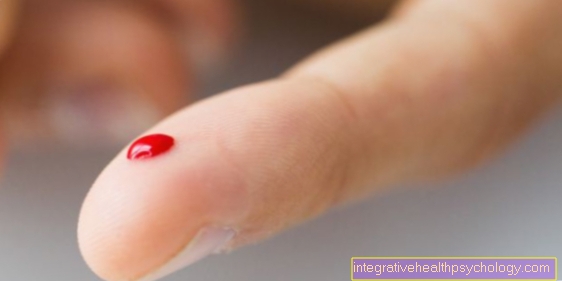







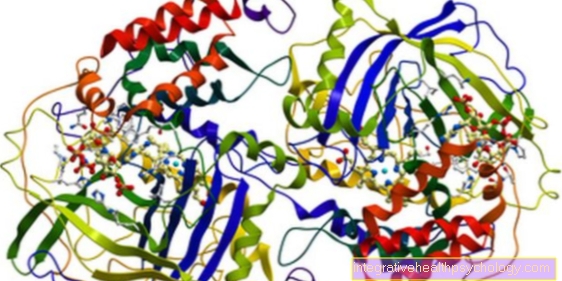
.jpg)













